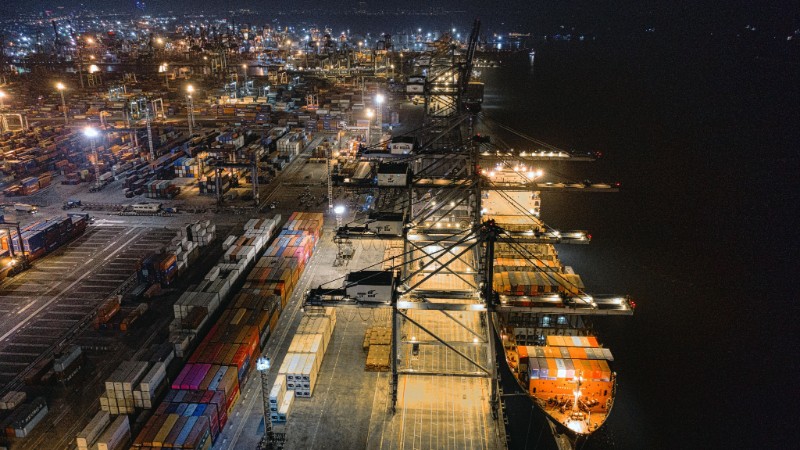How to Manage Tariff Risks When Importing from China
_1752109835047.jpg)
_1752109835047.jpg)
China is the most popular destination for global sourcing because of its strong factory groups and supply chain system. Although its overseas apparel production and exports have been sliding for more than 15 years, China still expresses resilience and dominates global production and exports.
However, risk management in tariff costs is an essential aspect that every sourcer must consider when importing from China. In recent years, factors like the US-China trade war and shifting trade policies have amplified the complexity of managing tariff risks.
As global policies continue to change, businesses must understand how to navigate these hidden costs effectively and reduce their exposure to potential financial risks. Let' get some insights.

Tariff fees are a significant part of the overall cost when importing from China and globally, especially for businesses that rely on imports. For example, the Trump administration's increase in duties on China will result in U.S. companies paying a higher price when importing products from China. So, risk management in tariff costs is one plan you must make.
While duties are necessary in global trade, managing their financial risks can help you stay highly competitive in a volatile global market.
All right, the first step in tariff cost risk management is recognizing the potential impact of duties on your business. There are different cost levels for diverse products. Besides, you'd better find another country as an alternative import destination. If the fee exceeds your expectations, import from the alternative immediately.
The duties imposed on imports from China have fluctuated in recent years, particularly during the trade war between the US and China. The US-China trade impact has been profound, with tariff rates increasing on certain goods, affecting various industries, including electronics, textiles, and machinery.
The trade war tariff risk has made it even more challenging for importers to predict costs accurately and plan for future imports. For instance, the risk can result in higher taxes on Chinese-made products entering the US, which forces businesses to pay more for the same goods. In some cases, companies may have to absorb these additional costs or pass them on to consumers, potentially losing competitiveness in the market.
Furthermore, sudden duty changes can disrupt the stability of supply chains, making it harder to plan for future orders and shipments. As tariffs fluctuate, businesses must adopt customs duties management strategies that allow them to stay flexible and mitigate the financial impact of changes in trade policies.

Effectively managing risk management in duties when importing from China involves a combination of proactive strategies, market insights, and financial planning. Below are several key strategies that can help businesses navigate the complexities of tariffs and minimize their exposure to unnecessary costs.
One of the first steps in risk management in tariff costs is developing a comprehensive duty planning strategy. This involves analyzing your product mix and assessing which products are most affected by fees. By identifying high-risk items and understanding the tariffs applied to them, businesses can better plan their imports and budget for potential related expenses.
Effective tariff planning for importers includes monitoring changes in customs rates, tracking relevant trade agreements, and being proactive about understanding how these factors may impact product costs. This type of planning allows businesses to anticipate potential duty increases and adjust their sourcing strategies accordingly. Importers should also stay informed about any upcoming policy changes, such as tariff reductions or trade deals, that may affect their imports.
When importing from China, customs duties management is a vital part of risk management in tariff costs. Customs duties are taxes that are paid on goods when they are imported into a country. These duties can add a significant expense to the cost of products, so understanding how to manage them is crucial for controlling overall costs.
The first step in customs duties management is understanding the specific duty rates for your products. Different products have different duty rates, and these rates can change based on the product’s classification under international trade law. Having a good relationship with your customs broker and staying up-to-date on tariff changes can help you minimize delays and avoid costly mistakes.
Additionally, businesses can explore duty reduction programs, such as the US Generalized System of Preferences (GSP), which allows importers to reduce or eliminate duties on certain products from eligible countries. Working with experienced customs experts can help you navigate this complex area of international trade and reduce the overall impact of customs duties on your imports.
One of the most effective ways to manage risk management in tariff costs is by sourcing around it. This involves finding alternative suppliers or manufacturing locations that can help reduce or eliminate the cost burden. For example, businesses can consider sourcing products from countries with lower or no duties on specific goods, even if that means moving production outside of China.
By diversifying suppliers or finding alternative sources for key products, businesses can lower their exposure to trade war tariff risk and gain greater flexibility in managing its impact. While this strategy may require additional time for research and development, it can help reduce the overall cost of goods and mitigate risks related to fluctuating tariff rates.

Cost-effective sourcing involves identifying suppliers that can offer the best price for quality goods while minimizing the impact of tariffs. This includes negotiating better pricing with existing suppliers, leveraging economies of scale, and ensuring that the costs are factored into the price of the product.
Additionally, businesses should consider implementing import tax strategies to manage the financial burden of fees. By working with experienced sourcing agents or consulting with experts in international trade, businesses can identify ways to optimize their procurement process and reduce costs. This might include negotiating lower pricing with suppliers or exploring new sourcing options that minimize tariff exposure.
The US-China trade impact is a critical factor when considering risk management in tariff costs. Over the past several years, the US and China have engaged in trade disputes that have affected numerous industries. As tensions between the two countries fluctuate, businesses must stay informed about the latest trade policies and tariff rates.
By understanding the broader economic implications of the US-China trade impact, businesses can adjust their sourcing strategies to minimize risk. For example, if tariffs on certain products are expected to rise, businesses can shift their sourcing to other regions or consider strategies such as stockpiling products before it increase takes effect. Staying informed about the political climate and trade negotiations will help businesses anticipate changes in customs policies and better prepare for potential disruptions.
An essential part of risk management in tariff costs is developing import tax strategies. These strategies are designed to help businesses manage the taxes and duties imposed on their imports while maximizing profitability. Import tax strategies can include:
• Leveraging free trade agreements and preferential trade terms to reduce duties
• Structuring the import process in a way that minimizes tax liabilities
• Working with customs brokers to ensure compliance with regulations while reducing costs
Having an experienced team of experts to guide your business through import tax strategies can help minimize the impact of customs duties management and ensure that your business is making the most of available tax-saving opportunities.

In conclusion, risk management in tariff costs is an essential aspect of importing from China, particularly in an environment where trade policies are subject to change. By understanding its complexities, developing effective tariff planning strategies, and exploring alternatives to mitigate related risks, businesses can better position themselves to thrive in the global marketplace.
Whether through careful sourcing around customs, implementing cost-effective sourcing strategies, or staying informed about the US-China trade impact, businesses can reduce the financial risks associated with duties. The key is to stay proactive, monitor changes in tariff policies, and ensure that you are working with experienced professionals who can help guide you through the challenges of international trade.
By focusing on these strategies, businesses can continue to source products from China effectively and manage related costs, ensuring long-term success in a competitive global market.
If you want to learn more about sourcing from China and how to manage tariff risks when importing from China. Please fill in the form and contact us!
Your trusted partner for sourcing from china.





